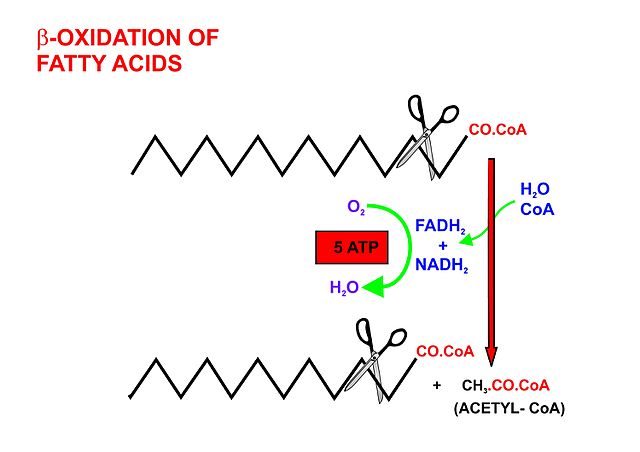In biochemistry and metabolism, beta oxidation (also β-oxidation) is the catabolic process by which fatty acid molecules are broken down in the cytosol in prokaryotes and in the mitochondria in eukaryotes to generate acetyl-CoA. Acetyl-CoA enters the citric acid cycle, generating NADH and FADH2, which are electron carriers used in the electron transport chain. It is named as such because the beta carbon of the fatty acid chain undergoes oxidation and is converted to a carbonyl group to start the cycle all over again. Beta-oxidation is primarily facilitated by the mitochondrial trifunctional protein, an enzyme complex associated with the inner mitochondrial membrane, although very long chain fatty acids are oxidized in peroxisomes.

A diagrammatic illustration of the process of lipolysis (in a fat cell) induced by high epinephrine and low insulin levels in the blood. Epinephrine binds to a beta-adrenergic receptor in the cell wall of the adipocyte, which causes cAMP to be generated inside the cell. The cAMP activates a protein kinase, which phosphorylates and activates a hormone-sensitive lipase in the fat cell. This lipase cleaves free fatty acids from their attachment to glycerol in the adipocyte. The free fatty acids and glycerol are then released into the blood.
A diagrammatic illustration of the transport of free fatty acids in the blood attached to plasma albumin, its diffusion across the cell membrane using a protein transporter, and its activation, using ATP, to form acyl-CoA in the cytosol. The illustration is of a 12 carbon fatty acid.
A diagrammatic illustration of the transfer of an acyl-CoA molecule across the inner membrane of the mitochondrion by carnitine-acyl-CoA transferase (CAT). The illustrated acyl chain is 12 carbon atoms long. CAT is inhibited by high concentrations of malonyl-CoA (the first committed step in fatty acid synthesis) in the cytoplasm. This means that fatty acid synthesis and fatty acid catabolism cannot occur simultaneously in any given cell.
A diagrammatic illustration of the process of the beta-oxidation of an acyl-CoA molecule in the mitochondrial matrix. During this process an acyl-CoA molecule which is 2 carbons shorter than it was at the beginning of the process is formed. Acetyl-CoA, water and 5 ATP molecules are the other products of each beta-oxidative event, until the entire acyl-CoA molecule has been reduced to a set of acetyl-CoA molecules.
Metabolism is the set of life-sustaining chemical reactions in organisms. The three main functions of metabolism are: the conversion of the energy in food to energy available to run cellular processes; the conversion of food to building blocks of proteins, lipids, nucleic acids, and some carbohydrates; and the elimination of metabolic wastes. These enzyme-catalyzed reactions allow organisms to grow and reproduce, maintain their structures, and respond to their environments. The word metabolism can also refer to the sum of all chemical reactions that occur in living organisms, including digestion and the transportation of substances into and between different cells, in which case the above described set of reactions within the cells is called intermediary metabolism.
This is a diagram depicting a large set of human metabolic pathways.[image reference needed]
Plant cells (bounded by purple walls) filled with chloroplasts (green), which are the site of photosynthesis
Santorio Santorio in his steelyard balance, from Ars de statica medicina, first published 1614





![This is a diagram depicting a large set of human metabolic pathways.[image reference needed]](https://upload.wikimedia.org/wikipedia/commons/thumb/a/a8/Human_Metabolism_-_Pathways.jpg/640px-Human_Metabolism_-_Pathways.jpg)

